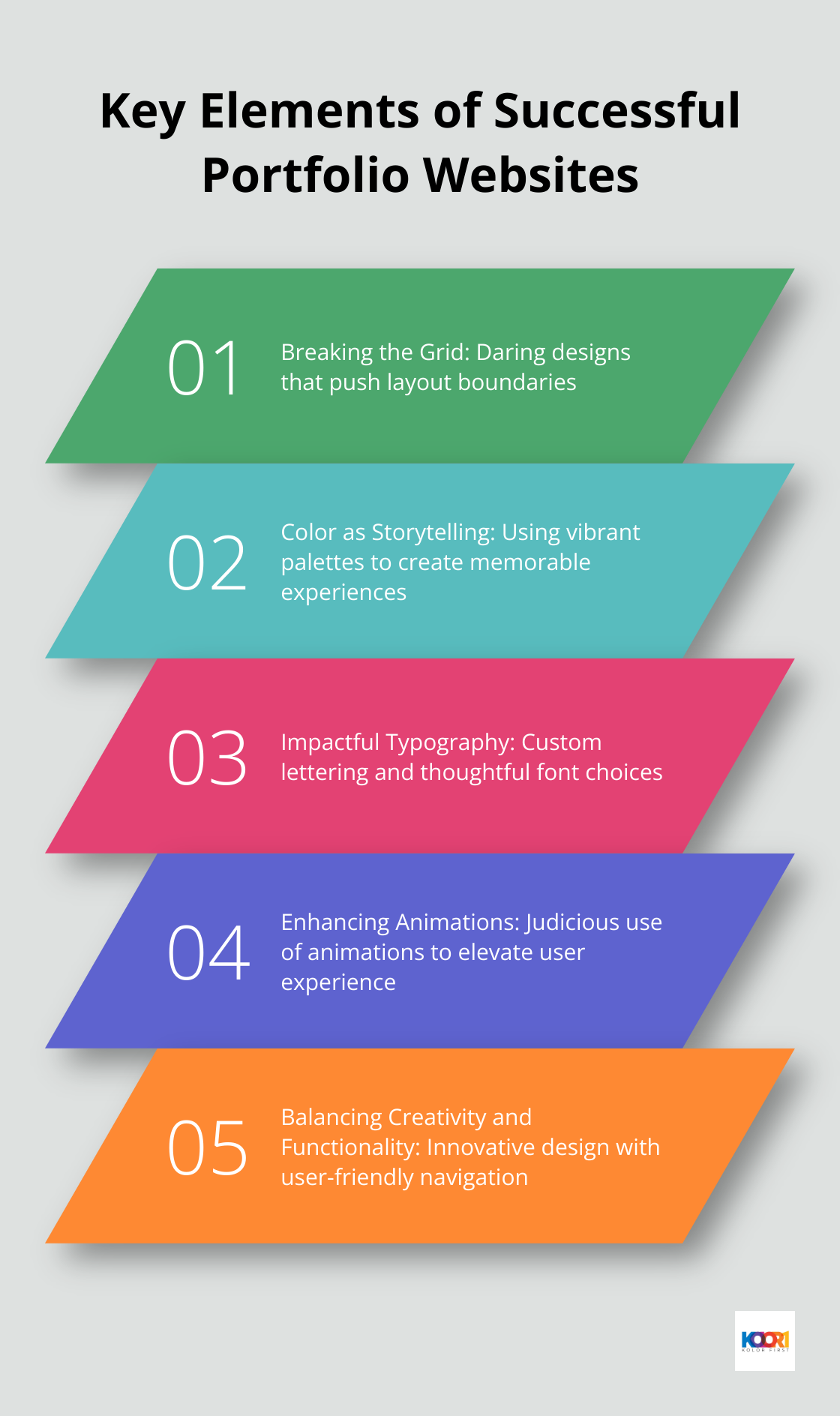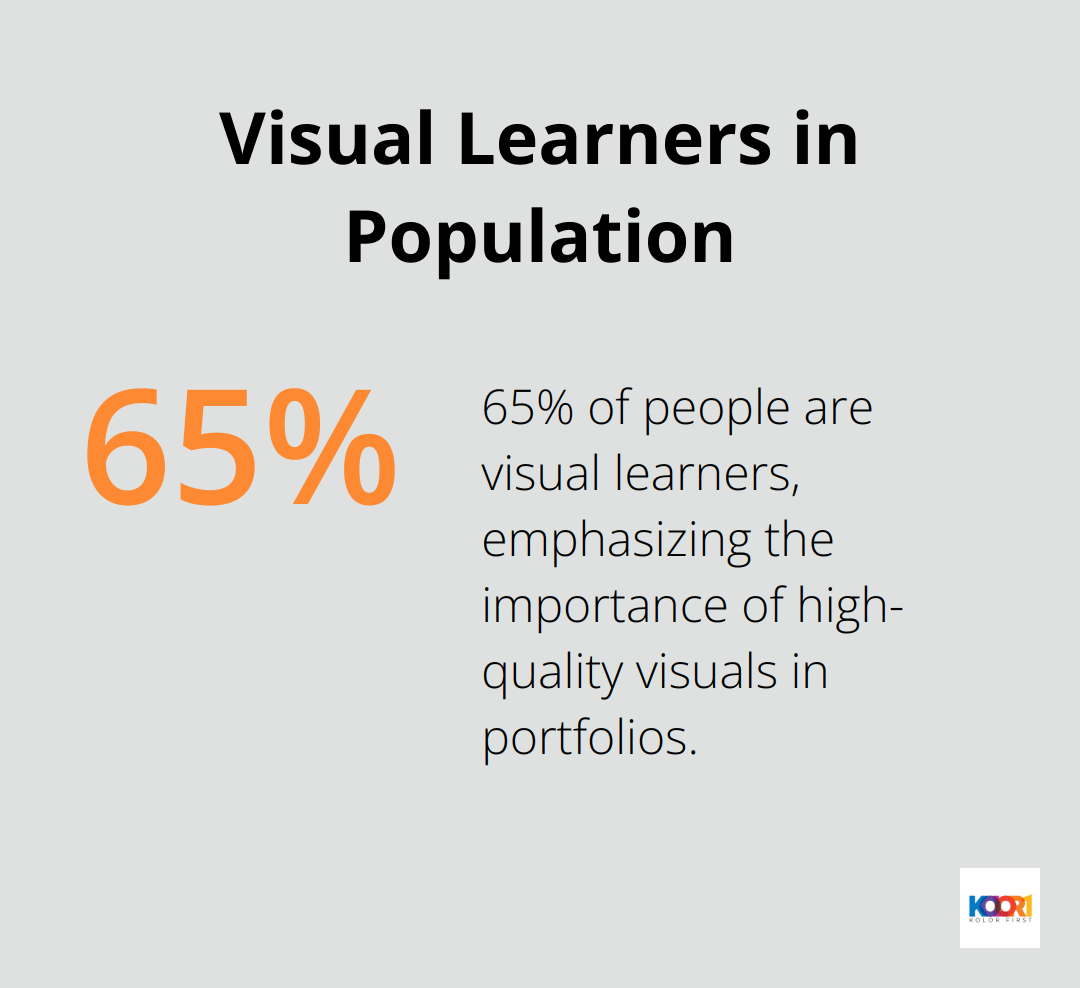At Kolorfirst LLC, we’re excited to explore the world of web design portfolio sites that captivate and inspire.
In this post, we’ll showcase outstanding examples, break down key elements of successful portfolios, and share practical tips for creating your own standout site.
Get ready to discover innovative layouts, effective use of color, and unique interactive elements that set these portfolios apart.
Standout Web Design Portfolios
Web design portfolios serve as a testament to creativity, skill, and innovation. We’ve explored the internet to bring you some of the most impressive examples that push the boundaries of digital presentation.
Breaking the Grid
Traditional layouts now give way to more daring designs. Tobias van Schneider’s portfolio exemplifies this trend. His use of big, fat text, and lots of photos creates a visually striking experience that keeps visitors engaged. This approach not only showcases his work but also demonstrates his ability to think outside the box.
Color as a Storytelling Tool
Color plays a pivotal role in setting the tone of a portfolio. Robby Leonardi’s interactive resume uses a vibrant color palette to create a playful, game-like experience. This clever use of color not only makes his portfolio memorable but also reflects his personality and approach to design.
Typography That Speaks Volumes
Typography can make or break a portfolio. Jessica Hische’s site offers a masterclass in typographic design. Her custom lettering and thoughtful font choices (which range from elegant serifs to modern sans-serifs) not only showcase her skills but also create a cohesive and professional look. The integration of typography with other design elements creates a harmonious visual experience that’s hard to forget.
Animations That Enhance User Experience
Animations, when used judiciously, can significantly elevate a portfolio. Bruno Simon’s 3D interactive portfolio takes this concept to the next level. As a creative developer living in Paris, Simon’s portfolio showcases his skills as a freelancer and former lead developer at Immersive Garden. This innovative approach not only demonstrates his technical abilities but also creates a unique and memorable user experience.
Balancing Creativity and Functionality
While creativity is essential, functionality remains paramount. The best portfolios strike a balance between innovative design and user-friendly navigation. They showcase the designer’s skills while ensuring visitors can easily find the information they need.
These creative approaches continue to inspire designers to experiment with new ideas while keeping user experience at the forefront. A great portfolio not only showcases work but also reflects a unique perspective and skills as a designer. As we move forward, let’s explore the key elements that make these portfolios truly successful.

What Makes a Portfolio Website Successful?
Clear Project Narratives
A successful portfolio website tells a compelling story. Each project should feature a concise description that outlines the problem, approach, and results. Users spend an average of 10-20 seconds on a web page before deciding to stay or leave (Nielsen Norman Group). This fact underscores the importance of grabbing attention quickly with informative project descriptions.
Don’t just list your actions. Explain the reasoning behind your design choices and how they benefited the client. For instance, instead of “Redesigned the homepage,” opt for “Increased conversion rates by 30% through strategic homepage redesign focusing on user flow and clear call-to-actions.”
Impactful Visuals and Case Studies
High-quality visuals are essential for a portfolio website. Use professional photography or high-resolution screenshots to showcase your work. Visual learners make up 65% of people (Social Science Research Network), which emphasizes the need for your visuals to effectively convey your skills and style.

Case studies elevate your portfolio by providing in-depth looks at your process, problem-solving skills, and results. A comprehensive case study should include:
- The initial brief or problem
- Your research and ideation process
- The final solution
- Measurable results or client feedback
User-Friendly Contact Options
A portfolio loses its value if potential clients can’t reach you easily. Include multiple contact options – email, phone, and a contact form at minimum. Make your call-to-action prominent and unmissable.
Adding a CTA button to article pages can increase conversion rates by 121% (HubSpot). Apply this principle to your portfolio. Don’t hide your contact information in a tiny footer. Place it front and center, making it impossible to overlook.
Mobile Responsiveness
In today’s mobile-first world, your portfolio must look great on all devices. Since 2015, a responsive design with mobile-friendly behavior is a must-have for those who care about ranks in search engines. This approach not only improves user experience but also boosts your search engine rankings.
Personal Branding
Your portfolio should reflect your unique style and personality. Consistent use of colors, fonts, and design elements across your site helps create a memorable brand identity. This cohesive approach (which extends to your social media profiles and other online presence) sets you apart from competitors and makes you more recognizable to potential clients.
A successful portfolio website combines clear narratives, impactful visuals, easy contact options, mobile responsiveness, and strong personal branding. These elements work together to create a powerful first impression that can help you land dream clients or jobs. In the next section, we’ll explore practical tips for creating your own standout portfolio site.
How to Build a Standout Portfolio Site
Creating a portfolio that stands out in the crowded digital landscape requires careful planning and execution. Here’s a practical guide to build a portfolio that will turn heads and win clients.
Choose Your Platform Wisely
The foundation of your portfolio is the platform you build it on. While WordPress remains a popular choice (powering 43% of all websites according to W3Techs), platforms like Webflow gain traction for their design flexibility and ease of use.
Consider your technical skills and the time you can invest in maintaining your site. If you’re comfortable with code, a static site generator like Jekyll or Hugo can offer fast performance. For those who prefer a visual approach, Webflow’s design customization might be the perfect fit.
Optimize for All Screens
Mobile optimization is essential. 53% of visits are abandoned if a mobile site takes longer than 3 seconds to load. Ensure your portfolio looks great on everything from smartphones to large desktop monitors.

Start with a mobile-first approach. Design for the smallest screen first, then enhance for larger displays. Use responsive images to ensure fast loading times on mobile devices. Tools like Responsinator can help you preview your site across various device sizes.
Keep It Fresh and Relevant
A stale portfolio can be worse than no portfolio at all. Set a schedule for regular updates – try to update at least once a quarter. This doesn’t just mean adding new projects; it also involves refining your existing content.
Use analytics tools to understand which projects get the most attention. Google Analytics can provide insights into visitor behavior, helping you make data-driven decisions about what to feature prominently.
When adding new work, focus on quality over quantity. One well-documented case study is worth more than several hastily added project thumbnails. Include metrics where possible – clients love to see tangible results.
Showcase Your Process
Don’t just show the final product; give visitors a peek behind the curtain. Document your design process, from initial sketches to final implementation. This transparency demonstrates your problem-solving skills and attention to detail.
Consider creating a short video walkthrough of your design process. According to Wyzowl, 84% of people say they’ve been convinced to buy a product or service by watching a brand’s video.
Your portfolio is more than just a collection of pretty pictures – it’s a testament to your skills, creativity, and professionalism. These tips will help you create a portfolio that not only showcases your best work but also tells your unique story as a designer.
Final Thoughts
Web design portfolio sites showcase the endless possibilities for presenting your work online. Innovative layouts, effective color use, and unique interactive elements set portfolios apart. These inspiring examples demonstrate how to break traditional grids and use typography as a powerful design tool.
A well-crafted online presence proves your skills, creativity, and professionalism. Your portfolio site can make the difference between landing your dream client and getting lost in the crowd. It’s your opportunity to make a lasting impression and show not just what you’ve done, but how you think and solve problems.
We at Kolorfirst LLC understand the power of a strong online presence. As an advertising agency specializing in creative branding and digital marketing solutions, we help businesses elevate their brand identities. We craft unique brand stories and deliver measurable growth for our clients (based on our experience with previous projects).






